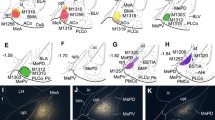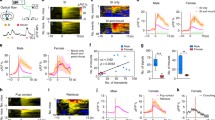Abstract
The medial amygdaloid nucleus (AME) occupies a central position in the circuitry that organizes sexual behavior in the male rat. It receives a projection from olfactory structures that are activated by pheromonal cues indicating receptivity in the female and projects in turn to limbic and hypothalamic structures that are thought to organize aspects of coitus. Electrical stimulation of the AME elicits a behavioral state that is indistinguishable by several measures from the post-ejaculatory interval. We used chronic single-unit recording techniques to determine the behavioral conditions in which the AME is normally active. We found that the cells indeed fired selectively during the presence of a receptive female, but that the discharge considerably anticipated copulation in time. We propose that sexual behavior in the male rat is a reaction chain of fixed action patterns, each one acting as a releaser for the next. The AME mediates an early event in the reaction chain, namely recognition of the receptive female, but electrical activation of the AME causes the reaction chain to proceed to its culminating behavior, the post-ejaculatory interval.
Similar content being viewed by others
References
Albeck D, Smock T (1988) A mechanism for vasopressin action in the hippocampus. Brain Res 463:394–397
Albeck D, Smock T, McMechen P, Purves D, Floyd L (1990) Peptidergic transmission in the brain. I. Vasopressin-like signal in the hippocampus. Brain Res 511:7–14
Albeck D, Smock T, Arnold S, Raese K, Paynter K, Colaprete S (1991a) Peptidergic transmission in the brain. IV. Sex hormone dependence in the vasopressin/oxytocin system. Peptides 12:53–56
Albeck D, Paynter K, Arnold S, Colaprete S, Knittle S, Bradley B, Okpaku A, Green JC, Grampsas S, Smock T (1991) Peptidergic transmission in the brain. VI. Behavioral consequences of central activation. Peptides 12:413–418
Albeck D, Bullock N, Marrs K, Cooper R, Smock T, DeVries G (1993) Antidromic activation of a peptidergic pathway in the limbic system. Brain Res 606:171–174
Argiolas A, Collu M, Gessa G, Melis M, Serra G (1988) The oxytocin antagonist d(CH3)3 Tyr (Me)-Orn8-vasotocin inhibits male copulatory performance in rats. Eur J Pharmacol 149:389–392
Arletti R, Bazzoni C, Castelli M, Bertolini A (1985) Oxytocin improves male copulatory performance in rats. Horm Behav 19:14–20
Barfield R, Geyer A (1975) The ultrasonic postejaculatory vocalization and postejaculatory refactory period of the male rat. J Comp Physiol Psychol 88:723–734
Beach FA (1967) Cerebral and hormonal control of reflexive mechanisms involved in copulatory behavior. Physiol Rev 47:289–316
Carmichael MS, Humbert R, Dixen J, Palmisano G, Greenleaf W, Davidson JM (1987) Plasma oxytocin increases in the human sexual response. J Clin Endocrinol Metab 64:27–31
Davis WJ (1976) Organizational concepts in the central motor networks of invertebrates. Adv Behav Biol 18:265–92
DeVries GJ, Buijs RM, VanLeeuwen FW, Caffé AR, Swaab DF (1985) The vasopressinergic innervation of the brain in normal and castrated rats. J Comp Neurol 233:236–254
Evoy WH, Kennedy D (1967) The central nervous organization underlying control of antagonistic muscles in the crayfish. I. Types of command fibers. J Exp Zool 165:223–38
Garritano J, Martinez C, Grossman K, Intermann P, Merritt K, Pfoff R, Smock T (1993) Medial amygdaloid inhibition of evoked hippocampal field potentials during sexual behaviors. Soc Neurosci Abstr (in press)
Goldberg E, Minerbo G, Smock T (1993) An inexpensive microdrive for chronic single unit recording. Brain Res Bull 32:321–232
Haris US, Sachs BD (1975) Copulatory behavior in male rats following amygdaloid lesions. Brain Res 86:514–518
Hughes AM, Everitt BJ, Lightman SL, Todd K (1987) Oxytocin in the central nervous system and sexual behavior in male rats. Brain Res 414:244–247
Kennedy D, Davis WJ (1977) Organization of invertebrate motor systems. In: Geiger SR, Kandel ER, Brookhart JM, Mountcastle VB (eds) Handbook of physiology, vol 1, part 2. American Physiological Society, Bethesda, Md
Kennedy D, Evoy WH, Dane B, Hanawalt JT (1967) The central nervous organization underlying control of antagonistic muscles in the crayfish. II. Coding of position by command fibers. J Exp Zool 165:239–48
Kristan WB, Weeks JC (1983) Neurons controlling the initiation, generation and modulation of leech swimming. In: Roberts AB, Roberts BL (eds) Neural origin of rhythmic movements. Society for Exp Biology Symp 37:243–60
Kurtz R, Adler N (1973) Electrophysiological correlates of copulatory behavior in the male rat: evidence for a sexual inhibitory process. J Comp Physiol Psych 84:225–239
Lehman MN, Winans SS, Powers JB (1980) Medial nucleus of the amygdala mediates chemosensory control of male hamster sexual behavior. Science 210:557–560
Lorenz K Z (1932) Betrachtungen über das Erkennen der arteigenen Triebhandlungen bei Vögeln. J Ornithol 80:50–98
Lorenz KZ (1935) Der Kumpan in der Umwelt des Vogels. J Ornithol 83:137–215
Melis MR, Argiolas A, Gessa GL (1986) Oxytocin-induced penile erection and yawning: site of action in the brain. Brain Res 398:259–265
Murphy MR, Seckl JR, Burton S, Checkley SA, Lightman P (1987) Changes in oxytocin and vasopressin secretion during sexual activity in men. J Clin Endocrinol Metab 65:738–741
Sachs BD, Meisel RL (1988) The physiology of male sexual behavior. In: Knobil E, Neill J (eds) The physiology of reproduction. Raven Press, New York, pp 1393–1485
Schleidt WM (1974) How “fixed” is the fixed action pattern? Z Tierpsychol 36:184–211
Sharma OP, Hays RL (1973) Release of an oxytocic substance following genital stimulation in bulls. J Reprod Fertil 35:359–362
Smock T, Albeck D, McMechen P, Purves D (1990) Peptidergic transmission in the brain. II. Mediation by a vasopressin-like peptide. Brain Res 511:15–20
Smock T, Albeck D, McMechen P (1991) Peptidergic transmission in the brain. III. Hippocampal inhibition by the amygdala. Peptides 12:47–51
Smock T, Arnold S, Albeck D, Emerson P, Garritano J, Burrows K, Derber W, Sanson C, Marrs K, Weatherly H, Kruse K (1992) A peptidergic circuit for reproductive behavior. Brain Res 598:138–142
Stoneham MD, Everitt BJ, Hansen S, Lightman SL, Todd K (1985) Oxytocin and sexual behavior in the male rat and rabbit. J Endocrinol 107:97–106
Tinbergen N (1935) Über die Orientierung des Bienenwolfes. II. Die Bienenjagd. J Vergl Physiol 21:699–716
Author information
Authors and Affiliations
Rights and permissions
About this article
Cite this article
Minerbo, G., Albeck, D., Goldberg, E. et al. Activity of peptidergic neurons in the amygdala during sexual behavior in the male rat. Exp Brain Res 97, 444–450 (1994). https://doi.org/10.1007/BF00241538
Received:
Accepted:
Issue Date:
DOI: https://doi.org/10.1007/BF00241538




